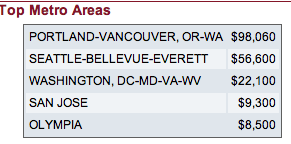These things don’t happen in a vacuum, and so it is not surprising to see Gov. Chris Gregoire joining the chorus of establishment voices demanding that the ballot deadline be changed from postmarked on election day to received by election day.
Earlier in the day, Gregoire said that the days, and potentially weeks, of not knowing the outcome of an election is hard not only on the candidates, but on the people who voted for them.
“Those candidates deserve to know. The people deserve to know,” Gregoire said about the counting process.
But as admirable as her empathy for her fellow politicians might be, the governor has yet to say a word about the real scandal in last Tuesday’s election: the forty-some thousand King County voters who were disenfranchised due to our state’s wholly inadequate ballot design and review procedures.
With the bulk of the ballots counted, my earlier analysis holds up. More than 9 percent of King County ballots fail to record a vote on Initiative 1033, compared to only 3 percent in the rest of the state. Meanwhile, the equally high profile Referendum 71, featured at the top of the ballot (as opposed to hidden underneath the instructions), enjoys a remarkably low 1.6 percent residual vote rate in King County, right in line with voters throughout the rest of the state.
And this otherwise inexplicable falloff in voting on I-1033 occurred despite the fact that the No campaign spent millions of dollars on TV ads that explicitly instructed voters on where to find the question on the King County ballot.
Gov. Gregoire and Secretary of State Sam Reed may not have noticed the scandal, but the Voting Technology Project at the Brennan Center for Justice has, citing the I-1033 vote as “more evidence, if any was needed, of the potential disenfranchising effects of poor design.”
But the Brennan Center goes further, actually recommending a very simple, reasonable and inexpensive reform:
What probably would have alerted officials to this problem ahead of time, and at little or no cost, would have been a simple usability test: observing ten or fifteen King County citizens as they “voted” on the ballot before the design was finalized. This solution is simple, easy and cheap. The Usability Professionals Association has a great explanation of how it’s done.
If county officials watched a dozen people fill out the ballot, at least a couple might have accidentally skipped the ballot initiative. And, with that, officials would have been alerted to the fact that their ballot contained a serious flaw.
The ballot eventually got it’s usability test, of course…but on Election Day. And approximately 40,000 voters showed — a little too late — that this particular ballot design failed.
Secretary of State Sam Reed has been pushing the ballot deadline issue hard behind the scenes, attempting to capitalize on what has been wrongly portrayed as a slow, long slog to determine the winner in the Seattle mayoral race. But while both he and Gov. Gregoire argue to fix a problem that is not a problem, with a solution that will not speed up election night reporting at all, they both ignore an obvious flaw in our elections system, that just disenfranchised tens of thousands of voters, and that can be easily fixed via a small, inexpensive procedural reform.
I don’t expect the Governor or the Secretary of State to agree with me on every issue. But I do expect them to have their priorities in order when it comes to something as basic to democracy as the integrity of our electoral process.

